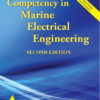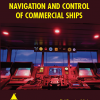Marine Electrical Technology – Eleventh Edition
The role of an engineer onboard a modern vessel is multifaceted and requires the knowledge and application of multiple engineering disciplines. Also, almost every piece of equipment is either controlled by or fed with electrical power.
This book caters to the structured curricula for Marine Engineering Pre-Sea Students, Marine Engineers of all post-sea competency levels and Electro Technical Officers of the Merchant Navy. This book can also be used as a reference material for other related courses and in libraries.
Comprising of 24 chapters in simple English, it explains not only the fundamentals but also the constructional features, operating principles, maintenance procedures and rules that govern the safe operation of all important electrical systems onboard a commercial ship.
Extracts from SOLAS Regulations, IACS Guidelines, Lloyd’s Register, Det Norske Veritas and American Bureau of Shipping Rules, have been included with permission. Many world-class organizations and manufacturers have extended their invaluable support and enriched the content too.
The Teaching Guide at the beginning of this book suggests a standard teaching methodology. The question bank, with a total of over 1000 questions, covers all topics that have been explained. This edition also contains about 600 relevant figures, including photographs that have been contributed by leading equipment manufacturers across the world.
Contents
| Chapter No. | Title | Page No. |
| 1 | Overview of a Ship’s Electrical System | 1 |
| 2 | Electrical Safety | 45 |
| 3 | Electrical Equipment for Hazardous Areas | 87 |
| 4 | AC Distribution Systems | 129 |
| 5 | Emergency Power and Shore Supply | 151 |
| 6 | Isolated and Earthed Neutral Systems | 181 |
| 7 | Alternators | 211 |
| 8 | Automatic Voltage Regulators and Exciters | 263 |
| 9 | Fixed and Portable Instrumentation | 297 |
| 10 | Paralleling of Alternators | 365 |
| 11 | Switchboards and Switchgear | 411 |
| 12 | Starters for Alternating Current Motors | 457 |
| 13 | Fault Protection Devices | 539 |
| 14 | Electric Cables | 613 |
| 15 | Insulation and Ingress Protection | 633 |
| 16 | Electrical Propulsion Systems | 661 |
| 17 | Steering Systems | 731 |
| 18 | Deck Machinery | 755 |
| 19 | Batteries and Battery Charging | 787 |
| 20 | Lighting Systems | 853 |
| 21 | Gas Analysers | 879 |
| 22 | Alarm Indication Systems | 907 |
| 23 | Miscellaneous Systems | 967 |
| 24 | Maintenance and Troubleshooting | 1017 |
| Addendum | ||
| Overcoming Common Difficulties in Rotating Machines | 1093 | |
| Index of Key Words and Articles | 1095 | |
| SOLAS Key | 1129 | |
| Chapter 1 – Overview of a Ship’s Electrical System | ||
| Article No. | Article | Page No. |
| 1.1 | The Marine Environment | 1 |
| 1.2 | Effects of Inclination | 2 |
| 1.3 | General Provisions | 4 |
| 1.4 | Installation and Basic Maintenance | 9 |
| 1.5 | Effects of Temperature | 9 |
| 1.6 | Systems and Major Components | 10 |
| 1.7 | Power Management Systems | 22 |
| 1.8 | Electrical Diagrams | 29 |
| 1.9 | Relevant SOLAS Regulations (Chapter II–1) | 41 |
| Chapter 2 – Electrical Safety | ||
| Article No. | Article | Page No. |
| 2.1 | Compliance with Regulations | 45 |
| 2.2 | The Inherent Dangers and Avoidance of Disastrous Consequences | 50 |
| 2.3 | Passive Safety Measures | 53 |
| 2.4 | Active Safety Measures | 56 |
| 2.5 | Fundamental Requirements for Safe Installation of Equipment | 60 |
| 2.6 | Dos and Don’ts While Working with Electrical Equipment | 61 |
| 2.7 | Danger Signals | 65 |
| 2.8 | Precautions for Preventing an Electric Shock | 65 |
| 2.9 | Conditions which Increase Danger to Personnel | 67 |
| 2.10 | Shock Risk with Portable AC Appliances | 68 |
| 2.11 | High Voltage Safety | 72 |
| 2.12 | Electrical Accidents | 76 |
| 2.13 | Maintenance of Records | 83 |
| Chapter 3 – Electrical Equipment for Hazardous Areas | ||
| Article No. | Article | Page No. |
| 3.1 | Tanker Installations | 87 |
| 3.2 | The International Electrotechnical Commission’s Ex Scheme | 93 |
| 3.3 | International Safety Standards | 97 |
| 3.4 | Ventilation when using Varnishes, Volatile Paints etc., Containing Solvents | 126 |
| Chapter 4 – AC Distribution Systems | ||
| Article No. | Article | Page No. |
| 4.1 | The General Concept | 129 |
| 4.2. | Common Systems for the Distribution of AC Power | 130 |
| 4.3 | Specific Systems for Ship’s Service | 132 |
| 4.4 | Distribution Systems Onboard Ships | 134 |
| 4.5 | General Distribution Scheme Onboard a Ship | 136 |
| 4.6 | Distribution Transformers | 138 |
| 4.7 | Isolation Transformers | 143 |
| 4.8 | General Scheme Applicable to all Types of Tankers | 144 |
| 4.9 | Example of a High-voltage System for a Liquefied Natural Gas Carrier | 146 |
| 4.10 | Primary Power Bus | 148 |
| 4.11 | Relevant Regulations | 149 |
| Chapter 5 – Emergency Power and Shore Supply | ||
| Article No. | Article | Page No. |
| 5.1 | The Method of Supplying Emergency Power | 151 |
| 5.2 | The Electronic Speed Relay | 165 |
| 5.3 | Arrangements for Periodic Testing | 166 |
| 5.4 | Transitional Source of Power | 167 |
| 5.5 | Operating Instructions | 168 |
| 5.6 | Shore Supply or Cold Ironing | 169 |
| 5.7 | Relevant Rules | 176 |
| Chapter 6 – Isolated and Earthed Neutral Systems | ||
| Article No. | Article | Page No. |
| 6.1 | Electromagnetic Compatibility | 181 |
| 6.2 | Isolated and Earthed Neutral Systems | 184 |
| 6.3 | Grounding | 187 |
| 6.4 | Significance of Earth Faults | 190 |
| 6.5 | Multiple Systems | 195 |
| 6.6 | Causes of Earth Faults | 195 |
| 6.7 | Prevention of Earth Faults | 197 |
| 6.8 | Earth Fault Monitors and Alarms | 198 |
| 6.9 | Basics of a Digital Earth Fault Monitor | 202 |
| 6.10 | Detection and Clearance of an Earth Fault | 203 |
| 6.11 | Relevant Rules | 207 |
| Chapter 7 – Alternators | ||
| Article No. | Article | Page No. |
| 7.1 | The Basic Concept | 211 |
| 7.2 | The Elementary Alternator | 213 |
| 7.3 | Rotor and Stator | 215 |
| 7.4 | Armature and Field | 216 |
| 7.5 | Rotating Armature Alternators | 216 |
| 7.6 | Rotating Field Alternators | 217 |
| 7.7 | The Brushless Alternator | 227 |
| 7.8 | The High-voltage Brushless Alternator | 234 |
| 7.9 | Outline of Operation of a Brushless Alternator | 236 |
| 7.10 | Generator Heating | 237 |
| 7.11 | Shaft-driven Alternators | 237 |
| 7.12 | Exhaust Gas Turbo-generator System | 248 |
| 7.13 | Advantages of Shaft Generators | 250 |
| 7.14 | Disadvantages of Shaft Generators | 250 |
| 7.15 | High Voltage Systems | 251 |
| 7.16 | Alternator Starting | 254 |
| 7.17 | Harmonics | 255 |
| 7.18 | Relevant Rules | 259 |
| Chapter 8 – Automatic Voltage Regulators and Exciters | ||
| Article No. | Article | Page No. |
| 8.1 | Performance Requirements of Alternators | 263 |
| 8.2 | Operating Principle of an AVR | 265 |
| 8.3 | Exciters and Excitation Systems | 265 |
| 8.4 | Thyristor-based Static Automatic Voltage Regulator | 268 |
| 8.5 | Alternative Thyristor-based AVR Circuits | 274 |
| 8.6 | Transformer-based Static Excitation System | 276 |
| 8.7 | Transient Voltage Dip and Alternator Response | 278 |
| 8.8 | Effect of kW Loading | 281 |
| 8.9 | Effect of kVAr Loading | 283 |
| 8.10 | Additional (Important) Features in a Modern AVR | 284 |
| 8.11 | Relevant ABS Rules | 293 |
| Chapter 9 – Fixed and Portable Instrumentation | ||
| Article No. | Article | Page No. |
| 9.1 | The Basics | 297 |
| 9.2 | Measuring System Terminology | 297 |
| 9.3 | Some Useful Fundamentals | 300 |
| 9.4 | In-Circuit Meters | 302 |
| 9.5 | Out-of-Circuit Meters | 303 |
| 9.6 | Permanent Magnet Moving Coil Meter | 303 |
| 9.7 | Power Measurement | 306 |
| 9.8 | The Electrodynamometer Wattmeter | 310 |
| 9.9 | Theory of an Electrodynamometer Wattmeter | 313 |
| 9.10 | Shape of the Scale of an Electrodynamometer Wattmeter | 315 |
| 9.11 | Power in Poly-Phase Systems – Blondel’s Theorem | 316 |
| 9.12 | Measurement of Active Power in Three-Phase Circuits | 316 |
| 9.13 | Active Power Transducer | 322 |
| 9.14 | Power Factor Measurement | 323 |
| 9.15 | Frequency Meters | 330 |
| 9.16 | The Synchroscope | 332 |
| 9.17 | Instrument Transformers | 337 |
| 9.18 | Digital Instruments | 341 |
| 9.19 | Portable Measuring Instruments | 345 |
| 9.20 | Relevant Rules | 361 |
| Chapter 10 – Paralleling of Alternators | ||
| Article No. | Article | Page No. |
| 10.1 | The Basics | 365 |
| 10.2 | Manual Synchronising | 368 |
| 10.3 | Check-synchronising Unit | 371 |
| 10.4 | Automatic Synchronising | 371 |
| 10.5 | Synchronising with the Aid of Lamps | 377 |
| 10.6 | Synchronising with the Aid of a Voltmeter | 379 |
| 10.7 | Parallel Operation | 380 |
| 10.8 | Excitation Control | 381 |
| 10.9 | Throttle Control | 383 |
| 10.10 | Load Sharing | 386 |
| 10.11 | Speed Droop and Power Generation | 399 |
| Chapter 11 – Switchboards and Switchgear | ||
| Article No. | Article | Page No. |
| 11.1 | Switchboards | 411 |
| 11.2 | Bus bars | 420 |
| 11.3 | Instrumentation and Controls | 424 |
| 11.4 | The Circuit Breaker (CB) | 427 |
| 11.5 | Circuit Breakers for Alternators | 432 |
| 11.6 | Moulded Case Circuit Breakers (MCCBs) | 444 |
| 11.7 | Miniature Circuit Breakers (MCBs) | 446 |
| 11.8 | Residual Current Circuit Breakers (RCCBs) | 448 |
| 11.9 | Arc Fault Current Interrupters | 449 |
| 11.10 | Fused Isolators | 450 |
| 11.11 | Effect of Harmonics at Receptacle Load Centres | 450 |
| 11.12 | Corrective and Preventive Actions in Case of a Fire in the Main Switchboard | 451 |
| 11.13 | Relevant Rules | 452 |
| Chapter 12 – Starters for Alternating Current Motors | ||
| Article No. | Article | Page No. |
| 12.1 | The Basics of Starters | 457 |
| 12.2 | The Contactor | 463 |
| 12.3 | The Direct-on-line or D.O.L. Starter | 465 |
| 12.4 | The Star-delta Starter | 489 |
| 12.5 | Starting Torque of a Squirrel-cage Type of Motor | 502 |
| 12.6 | Autotransformer Starter | 505 |
| 12.7 | Electronic Starters | 508 |
| 12.8 | Automatic Starting of Standby Motors | 527 |
| 12.9 | Speed Control of Induction Motors | 530 |
| Chapter 13 – Fault Protection Devices | ||
| Article No. | Article | Page No. |
| 13.1 | Identifying the Need for Circuit Protection | 539 |
| 13.2 | Direct Shorts | 540 |
| 13.3 | Excessive Current | 543 |
| 13.4 | Excessive Heat | 543 |
| 13.5 | Over-voltage | 544 |
| 13.6 | Surge | 545 |
| 13.7 | Transients | 547 |
| 13.8 | Ripple | 549 |
| 13.9 | Spikes | 549 |
| 13.10 | Overload | 550 |
| 13.11 | Circuit Protection | 550 |
| 13.12 | Alternator and Associated Systems’ Protection | 551 |
| 13.13 | Protection Scheme on a High-voltage System (LNG Vessel) | 565 |
| 13.14 | Protection through Fuses | 566 |
| 13.15 | Protection Discrimination and Selective Coordination | 589 |
| 13.16 | Motor Protection | 592 |
| 13.17 | Cable Protection | 605 |
| 13.18 | Busbar Protection | 606 |
| 13.19 | Relevant Rules | 607 |
| Chapter 14 – Electric Cables | ||
| Article No. | Article | Page No. |
| 14.1 | The Basics | 613 |
| 14.2 | Conductors | 614 |
| 14.3 | Temperature Coefficient | 615 |
| 14.4 | Current Rating and Voltage Drop | 615 |
| 14.5 | Cable Sizes | 617 |
| 14.6 | US and British Comparative Sizes for Cables and Lines | 617 |
| 14.7 | Cable Testing | 620 |
| 14.8 | Electrical Cable Codes | 621 |
| 14.9 | Practical Tips on Wiring | 626 |
| 14.10 | Relevant Rules | 629 |
| Chapter 15 – Insulation and Ingress Protection | ||
| Article No. | Article | Page No. |
| 15.1 | The Basics | 633 |
| 15.2 | Classes of Insulation | 634 |
| 15.3 | Ageing of Insulation | 636 |
| 15.4 | Insulating Materials generally used in a Low to Medium Power AC Motor | 637 |
| 15.5 | Motor Ratings versus Temperature | 638 |
| 15.6 | Temperature Ratings | 639 |
| 15.7 | Temperature Rise | 639 |
| 15.8 | Determination of Hot Temperature | 640 |
| 15.9 | Conductor Insulation | 643 |
| 15.10 | Insulating Materials | 646 |
| 15.11 | Separators and Fillers | 649 |
| 15.12 | Cable Sheath | 649 |
| 15.13 | Cable Gland | 652 |
| 15.14 | Plugs and Sockets for Reefer Containers | 654 |
| 15.15 | Degrees of Protection for an Enclosure | 655 |
| Chapter 16 – Electrical Propulsion Systems | ||
| Article No. | Article | Page No. |
| 16.1 | Layout and General Features | 661 |
| 16.2 | Optimising Storage Space | 664 |
| 16.3 | Ships Equipped with an Auxiliary Propulsion System | 665 |
| 16.4 | Electrical Propulsion | 667 |
| 16.5 | Advantages of Electrical Propulsion | 669 |
| 16.6 | Disadvantages of Electrical Propulsion | 670 |
| 16.7 | Turbo-electric Propulsion | 671 |
| 16.8 | The Synchronous Motor | 674 |
| 16.9 | AC Single-Speed Drive with a Controllable Pitch Propeller | 679 |
| 16.10 | AC Induction Motor Drive with a Controllable Pitch Propeller | 680 |
| 16.11 | Fixed-Speed Alternators with Variable-Speed Synchronous Motors | 682 |
| 16.12 | Cycloconverter Method of Speed Control | 683 |
| 16.13 | Advanced Diesel-electric Propulsion Systems | 684 |
| 16.14 | Thruster Propulsion Systems | 704 |
| 16.15 | Relevant Rules | 725 |
| Chapter 17 – Steering Systems | ||
| Article No. | Article | Page No. |
| 17.1 | Fundamental Concepts | 731 |
| 17.2 | Synchros for Rudder Angle and Course Indication | 747 |
| 17.3 | The Rate of Turn Indicator | 749 |
| 17.4 | Steering Gear Testing and Drills | 749 |
| 17.5 | Relevant Rules | 751 |
| Chapter 18 – Deck Machinery | ||
| Article No. | Article | Page No. |
| 18.1 | The Anchor Windlass | 755 |
| 18.2 | Safety Cut-outs of Passenger Lifts | 767 |
| 18.3 | Deck Cranes | 767 |
| 18.4 | Deck Machinery Control Systems | 769 |
| 18.5 | Safety Features in Modern Cranes | 779 |
| 18.6 | Gantry Travelling Slewing Crane | 783 |
| 18.7 | Crane Checks Prior to Cargo Operation | 783 |
| Chapter 19 – Batteries and Battery Charging | ||
| Article No. | Article | Page No. |
| 19.1 | The Primary Cell | 787 |
| 19.2 | The Secondary Cell | 788 |
| 19.3 | Electrochemical Action | 788 |
| 19.4 | Battery Supplies | 789 |
| 19.5 | Lead-Acid Storage Batteries | 790 |
| 19.6 | The Wet or Flooded Cell | 791 |
| 19.7 | Maintenance-free Sealed Lead-acid Batteries | 797 |
| 19.8 | Electrical Characteristics of the Lead-acid Cell | 802 |
| 19.9 | Polarization of the Cell | 809 |
| 19.10 | Local Action | 810 |
| 19.11 | Nickel-Cadmium Storage Batteries | 810 |
| 19.12 | Silver-Zinc Cell | 814 |
| 19.13 | Silver-Cadmium Cell | 814 |
| 19.14 | Lithium Ion Battery for 406 MHz EPIRBs | 815 |
| 19.15 | Battery Charging | 816 |
| 19.16 | Charging of Lead-Acid Batteries | 818 |
| 19.17 | Charging of Nickel Cadmium Batteries | 824 |
| 19.18 | Thermal Runaway | 825 |
| 19.19 | Methods of Charging | 826 |
| 19.20 | Single-Rate and Two-Rate Battery Chargers | 828 |
| 19.21 | Automatic Thyristor-controlled Battery Charger | 831 |
| 19.22 | Lifeboat Battery Charger | 837 |
| 19.23 | Battery Installations and Safety Measures | 838 |
| 19.24 | First Aid Treatment for Contact due to Spillage | 844 |
| 19.25 | Reclaiming, Recycling and Re-using Lead Acid Batteries | 844 |
| 19.26 | Relevant Rules | 845 |
| Chapter 20 – Lighting Systems | ||
| Article No. | Article | Page No. |
| 20.1 | The Basics | 853 |
| 20.2 | Incandescent Lamps | 855 |
| 20.3 | Discharge Lamps | 858 |
| 20.4 | Hot Cathode Low Pressure Mercury Fluorescent Lamps | 858 |
| 20.5 | High Pressure Mercury Fluorescent Lamps | 863 |
| 20.6 | Low Pressure Sodium Vapour Lamps | 864 |
| 20.7 | High Pressure Sodium Vapour Lamps | 864 |
| 20.8 | Disposal of Lamps Containing Mercury | 865 |
| 20.9 | Lamp Caps | 867 |
| 20.10 | Effects of Voltage on the Performance of Lamps | 868 |
| 20.11 | Navigation and Signal Lights | 868 |
| 20.12 | Modern LED-based Navigation Lights | 873 |
| 20.13 | Signals for a Power-driven Ship Under Way (At Night) | 873 |
| 20.14 | Emergency Lighting | 874 |
| 20.15 | Relevant Rules | 876 |
| Chapter 21 – Gas Analysers | ||
| Article No. | Article | Page No. |
| 21.1 | The Combustible Gas Indicator (CGI) or Explosimeter | 879 |
| 21.2 | The Tankscope | 884 |
| 21.3 | Thick Film Technology Gas Analysis | 889 |
| 21.4 | Carbon Monoxide and Carbon Dioxide Analysis | 891 |
| 21.5 | Portable Oxygen Analyser – Model: Draeger E-11 | 894 |
| 21.6 | Fixed Oxygen Analyser – Beckman Oxygen Analyser (Pauling Cell Type) | 898 |
| 21.7 | Beckman Oxygen Analyser (Munday Cell Type) | 899 |
| 21.8 | Zirconia Oxygen Analysis | 903 |
| 21.9 | Things to Remember in Gas Dangerous Areas | 904 |
| 21.10 | Relevant Rules | 905 |
| Chapter 22 – Alarm Indication Systems | ||
| Article No. | Article | Page No. |
| 22.1 | Fire Alarms and Detection | 909 |
| 22.2 | Heat Detectors | 912 |
| 22.3 | The Combustion Detector | 914 |
| 22.4 | Detectors Reacting to Radiation Emanating from Flames | 917 |
| 22.5 | The Fire Alarm Control Panel | 919 |
| 22.6 | Fire Fighting Systems | 925 |
| 22.7 | Modern Methods of Fire Detection and Suppression | 930 |
| 22.8 | Crankcase Oil Mist Detector | 934 |
| 22.9 | Dead Man Alarm | 945 |
| 22.10 | Miscellaneous Alarm Indication Systems | 949 |
| 22.11 | Scanning-type System | 952 |
| 22.12 | Communication Systems | 959 |
| 22.13 | Relevant Rules | 960 |
| Chapter 23 – Miscellaneous Systems | ||
| Article No. | Article | Page No. |
| 23.1 | Introduction | 967 |
| 23.2 | Cathodic Protection | 967 |
| 23.3 | Marine Growth Prevention System | 982 |
| 23.4 | Shaft Earthing System | 984 |
| 23.5 | Monitoring of Water Purity | 989 |
| 23.6 | Galley Equipment | 993 |
| 23.7 | Laundry Equipment | 996 |
| 23.8 | Water-tight Doors | 997 |
| 23.9 | Water Ingress Detection System for Cargo Holds | 1003 |
| 23.10 | Refrigerating Machinery | 1003 |
| 23.11 | The Reefer Container | 1008 |
| 23.12 | Air-conditioning Systems | 1009 |
| Chapter 24 – Maintenance and Troubleshooting | ||
| Article No. | Article | Page No. |
| 24.1 | The Basics of Maintenance | 1027 |
| 24.2 | Planned Preventive Maintenance | 1028 |
| 24.3 | Performance / Condition Monitoring | 1037 |
| 24.4 | Life Maintenance | 1040 |
| 24.5 | Breakdown or Corrective Maintenance | 1040 |
| 24.6 | Troubleshooting | 1040 |
| 24.7 | Maintenance of Specific Equipment | 1050 |
| 24.8 | Routine Maintenance Checklist Suggested by a few Classification Societies | 1084 |
| 24.9 | The Recommended List of Spares, Tools and Accessories for Maintenance | 1086 |
| 24.10 | Relevant Rules | 1087 |






